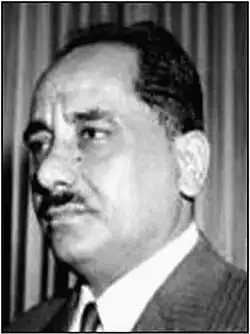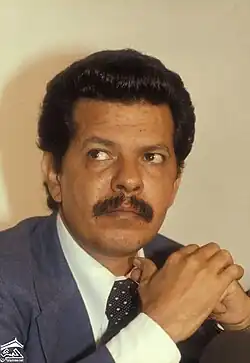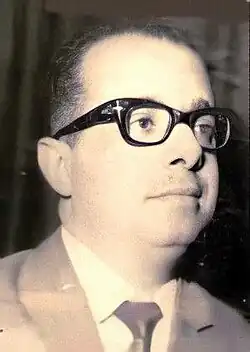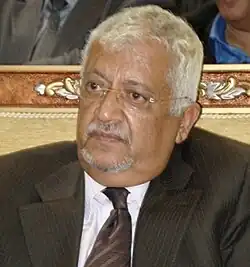General Secretary of the Yemeni Socialist Party
| General Secretary of the Yemeni Socialist Party | |
|---|---|
| الأمين العام للحزب الاشتراكي اليمني | |
 | |
Incumbent since 19 December 2014Abdulrahman Al-Saqqaf | |
| Formation | 13 October 1978 |
| First holder | Abdul Fattah Ismail |
| Final holder | Abdulrahman Al-Saqqaf |
The People's Democratic Republic of Yemen became independent as the "People's Republic of Southern Yemen" in November 1967, after the British withdrawal from the Federation of South Arabia and the Protectorate of South Arabia. In May 1990, South Yemen unified with the Yemen Arab Republic (commonly referred to as North Yemen) to form the united Republic of Yemen. During the May–July 1994 Civil War, South Yemen seceded from the united Yemen and established the short-lived Democratic Republic of Yemen.
Predecessors
National Liberation Front (1963–1975)
| No. | Officeholder | Took office | Left office | Length of tenure | Term | Birth | PM | Death | Ref. | |
|---|---|---|---|---|---|---|---|---|---|---|
| 1 | 
|
Qahtan al-Shaabi (قحطان محمد الشعبي) |
19 August 1963 | 22 June 1969 | 5 years, 307 days | 1st–4th (1965–1969) |
1920 | 1963 | 1981 | [1] |
| 2 | 
|
Abdul Fattah Ismail (عبد الفتاح إسماعيل) |
22 June 1969 | 14 October 1975 | 6 years, 114 days | 4th–5th (1969–1975) |
1939 | 1963 | 1986 | [2] |
People's Democratic Union (1961–1975)
| No. | Officeholder | Took office | Left office | Length of tenure | Term | Birth | PM | Death | Ref. | |
|---|---|---|---|---|---|---|---|---|---|---|
| 1 | 
|
Abdullah Badheeb (عبد الله باذيب) |
22 October 1961 | 14 October 1975 | 13 years, 357 days | 1st–2nd (1961–1975) |
1931 | 1961 | 1976 | [3] |
People's Vanguard Party (1974–1975)
| No. | Officeholder | Took office | Left office | Length of tenure | Birth | PM | Death | Ref. |
|---|---|---|---|---|---|---|---|---|
| 1 | Anis Hasan Yahya (أنيس_حسن_يحيى) |
April 1974 | 14 October 1975 | 1 year, 196 days | 1934 | 1974 | Alive | [4] |
Unified Nationalist Front Political Organization (1975–1978)
| No. | Officeholder | Took office | Left office | Length of tenure | Term | Birth | PM | Death | Ref. | |
|---|---|---|---|---|---|---|---|---|---|---|
| 1 | 
|
Abdul Fattah Ismail (عبد الفتاح إسماعيل) |
14 October 1975 | 13 October 1978 | 2 years, 364 days | 6th–7th (1975–1978) |
1939 | 1963 | 1986 | [2] |
Officeholders
| No. | Officeholder | Took office | Left office | Length of tenure | Term | Birth | PM | Death | Ref. | |
|---|---|---|---|---|---|---|---|---|---|---|
| 1 | 
|
Abdul Fattah Ismail (عبد الفتاح إسماعيل) |
13 October 1978 | 20 April 1980 | 1 year, 190 days | 1st (1978–1980) |
1939 | 1978 | 1986 | [1] |
| 2 | .jpg)
|
Ali Nasir Muhammad (علي ناصر محمد) |
21 April 1980 | 24 January 1986 | 5 years, 278 days | 1st–2nd (1978–1986) |
1939 | 1978 | Alive | [5] |
| 3 | .png)
|
Ali Salem al-Beidh (علي سالم البيض) |
6 February 1986 | 7 July 1994 | 8 years, 151 days | 3rd (1986–1998) |
1939 | 1978 | Alive | [6] |
| 4 | — | Ali Saleh Obad (علي صالح عباد) |
September 1994 | 31 July 2005 | 10 years, 333 days | 3rd–4th (1986–2005) |
1942 | 1978 | 2019 | [7] |
| 5 | 
|
Yasin Said Numan (ياسين سعيد نعمان) |
31 July 2005 | 19 December 2014 | 9 years, 141 days | 5th (2005–present) |
1947 | 1978 | Alive | [8] |
| 6 | — | Abdulrahman Al-Saqqaf (عبد الرحمن السقاف) |
19 December 2014 | Incumbent | 10 years, 241 days | 5th (2005–present) |
1956 | ? | Alive | [9] |
See also
References
Books
- Brehoney, Noel (2011). Yemen Divided: The Story of a Failed State in South Arabia. I.B. Tauris. ISBN 978-1-84885-635-6.
- Halliday, Fred (2002). Revolution and Foreign Policy: The Case of South Yemen, 1967–1987. Cambridge University Press. ISBN 0-521-89164-7.
- Naumkin, Vitaly V. (2004). Red Wolves of Yemen: The Struggle for Independence. The Oleander Press. ISBN 0-906672-70-8.
Book sections
- Ishiyama, John (2019). Feliu, Laura; Izquierdo-Brichs, Ferran (eds.). Communism and organizational symbiosis in South Yemen: The People’s Democratic Union, the National Liberation Front and the Yemeni Socialist Party. Routledge. pp. 168–183. ISBN 978-0-367-13445-7.
Web articles
- "علي سالم البيض" [Ali Salem Al-Beidh] (in Arabic). Al Jazeera Media Network. 29 September 2014. Archived from the original on 19 April 2025. Retrieved 10 August 2025.
- "صحيفة محلية تختار ياسين سعيد نعمان شخصية العام 2013" [Local newspaper selects Yassine Saeed Noman as Person of the Year 2013] (in Arabic). Almasdar Online. 2 January 2014. Archived from the original on 5 September 2014. Retrieved 10 August 2025.
- "صنعاء .. وفاة أمين عام الحزب الاشتراكي الأسبق علي صالح عباد" [Sanaa.. Former Secretary General of the Socialist Party Ali Saleh Abbad Dies] (in Arabic). Sa24. 1 March 2019. Archived from the original on 10 August 2025. Retrieved 10 August 2025.
- ""الاشتراكي" اليمني: تغييرات قياديّة وطموحات سياسيّة" [Yemeni Socialist Party: Leadership Changes and Political Ambitions]. The New Arab (in Arabic). 20 December 2014. Archived from the original on 10 August 2025. Retrieved 10 August 2025.
Footnotes
- ^ a b Halliday 2002, p. 336; Brehoney 2011, p. 120; Ishiyama 2019, p. 174.
- ^ a b Halliday 2002, p. 336; Ishiyama 2019, p. 174.
- ^ Brehoney 2011, pp. 15 & 56.
- ^ Naumkin 2004, p. 62.
- ^ Halliday 2002, p. 336; Ishiyama 2019, pp. 178–181.
- ^ Halliday 2002, p. 336; Al Jazeera 2014; Ishiyama 2019, pp. 177–178.
- ^ Ishiyama 2019, pp. 179–180; Sa24 2019.
- ^ Almasdar Online 2014, p. 181; Ishiyama 2019.
- ^ The New Arab 2014.
.svg.png)